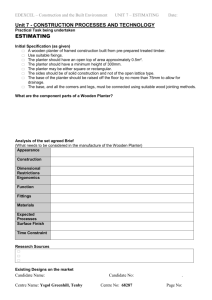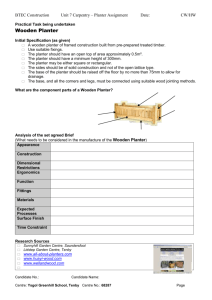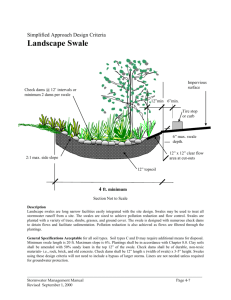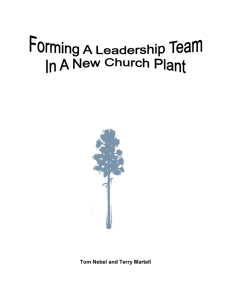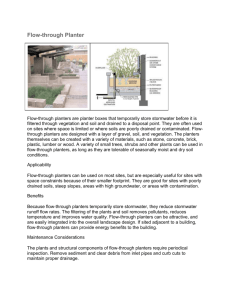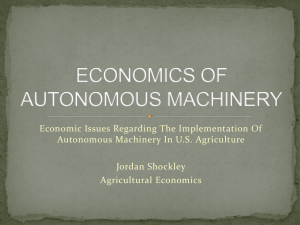X - Low Impact Development Center
advertisement
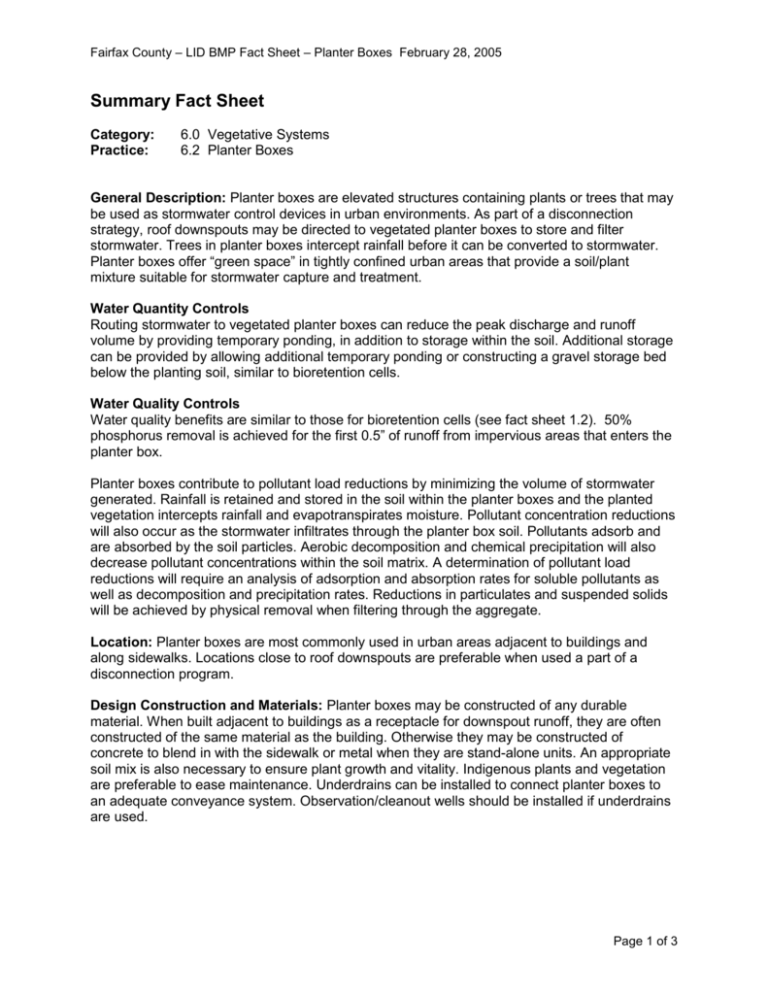
Fairfax County – LID BMP Fact Sheet – Planter Boxes February 28, 2005 Summary Fact Sheet Category: Practice: 6.0 Vegetative Systems 6.2 Planter Boxes General Description: Planter boxes are elevated structures containing plants or trees that may be used as stormwater control devices in urban environments. As part of a disconnection strategy, roof downspouts may be directed to vegetated planter boxes to store and filter stormwater. Trees in planter boxes intercept rainfall before it can be converted to stormwater. Planter boxes offer “green space” in tightly confined urban areas that provide a soil/plant mixture suitable for stormwater capture and treatment. Water Quantity Controls Routing stormwater to vegetated planter boxes can reduce the peak discharge and runoff volume by providing temporary ponding, in addition to storage within the soil. Additional storage can be provided by allowing additional temporary ponding or constructing a gravel storage bed below the planting soil, similar to bioretention cells. Water Quality Controls Water quality benefits are similar to those for bioretention cells (see fact sheet 1.2). 50% phosphorus removal is achieved for the first 0.5” of runoff from impervious areas that enters the planter box. Planter boxes contribute to pollutant load reductions by minimizing the volume of stormwater generated. Rainfall is retained and stored in the soil within the planter boxes and the planted vegetation intercepts rainfall and evapotranspirates moisture. Pollutant concentration reductions will also occur as the stormwater infiltrates through the planter box soil. Pollutants adsorb and are absorbed by the soil particles. Aerobic decomposition and chemical precipitation will also decrease pollutant concentrations within the soil matrix. A determination of pollutant load reductions will require an analysis of adsorption and absorption rates for soluble pollutants as well as decomposition and precipitation rates. Reductions in particulates and suspended solids will be achieved by physical removal when filtering through the aggregate. Location: Planter boxes are most commonly used in urban areas adjacent to buildings and along sidewalks. Locations close to roof downspouts are preferable when used a part of a disconnection program. Design Construction and Materials: Planter boxes may be constructed of any durable material. When built adjacent to buildings as a receptacle for downspout runoff, they are often constructed of the same material as the building. Otherwise they may be constructed of concrete to blend in with the sidewalk or metal when they are stand-alone units. An appropriate soil mix is also necessary to ensure plant growth and vitality. Indigenous plants and vegetation are preferable to ease maintenance. Underdrains can be installed to connect planter boxes to an adequate conveyance system. Observation/cleanout wells should be installed if underdrains are used. Page 1 of 3 Fairfax County – LID BMP Fact Sheet – Planter Boxes February 28, 2005 Planter boxes typically consist of the following cost components: Item Unit Estimated unit cost (2005 Dollars) Planter box construction (concrete) C.Y. $75 - $125 Vegetation planting Ea. $5 - $20 Soil media C.Y. $15 - $25 4” dia. perforated underdrain pipe L.F. $8 - $12 Cost: The cost for a planter box system to treat runoff from ½ impervious acre is comprised of both the installation cost and annualized costs. These cost calculations were based upon a planter box system with a total surface area of 500 ft2. A planter box is assumed to have a lifespan of 25 years, at which point it will be removed and replaced. Item Required Cost per Year (2005 Dollars) 1 2 3 4 5 6 7 8 9 10 Mulching, Weeding, and Debris Removal 300 300 300 300 300 300 300 300 300 300 Replace Vegetation 100 100 100 100 100 100 100 100 100 100 Installation1 0 500 500 Remove & Replace Annualized Cost 25 4,000 Concrete Repair Total Cost … 4,000 4,000 400 400 400 400 900 400 400 400 400 900 4,000 $625/ year (includes replacement in year 25) 1 Developer Cost. Not included in annualized cost. Maintenance: Maintenance activities entail routine inspections of the planter box structure and the underdrain. Soils also need to be inspected to evaluate root growth and channel formation within the soil matrix. Performance and Inspection: To ensure proper performance, visually inspect that stormwater is infiltrating properly into the planter box soil and that there is discharge from the underdrain during large wet weather events. Water ponding in a planter box for more than 24 hours may indicate operational problems. If excessive water ponding is observed, corrective measures include inspection for soil compaction and for underdrain clogging. The soil media may need to be turned or tilled to improve infiltration and the vegetation replaced. Backflushing the underdrain may be able to remove obstructions. If these efforts are unsuccessful, the soil media and underdrain may need to be removed and replaced. Page 2 of 3 Fairfax County – LID BMP Fact Sheet – Planter Boxes February 28, 2005 Planter Box Source: LID Center Potential LEED Credits: Primary: Sustainable Sites – Credit 6 “Stormwater Management” (1-2 Points) Sustainable Sites – Credit 7 “Landscape & Exterior Design to Reduce Heat Islands” (1-2 Points) Water Efficiency – Credit 1 “Water Efficient Landscaping” (1-2 Points) Other: Water Efficiency – Credit 3 “Water Use Reduction” (1-2 Points) Innovation & Design Process (1-4 Points) Links to Additional Information: Fairfax County PFM: http://www.co.fairfax.va.us/dpwes/publications/pfm/6.htm Virginia Stormwater Management Handbook: http://www.dcr.virginia.gov/sw/stormwat.htm#pubs Northern Virginia BMP Handbook: http://www.novaregion.org/pdf/NVBMP-Handbook.pdf Page 3 of 3
